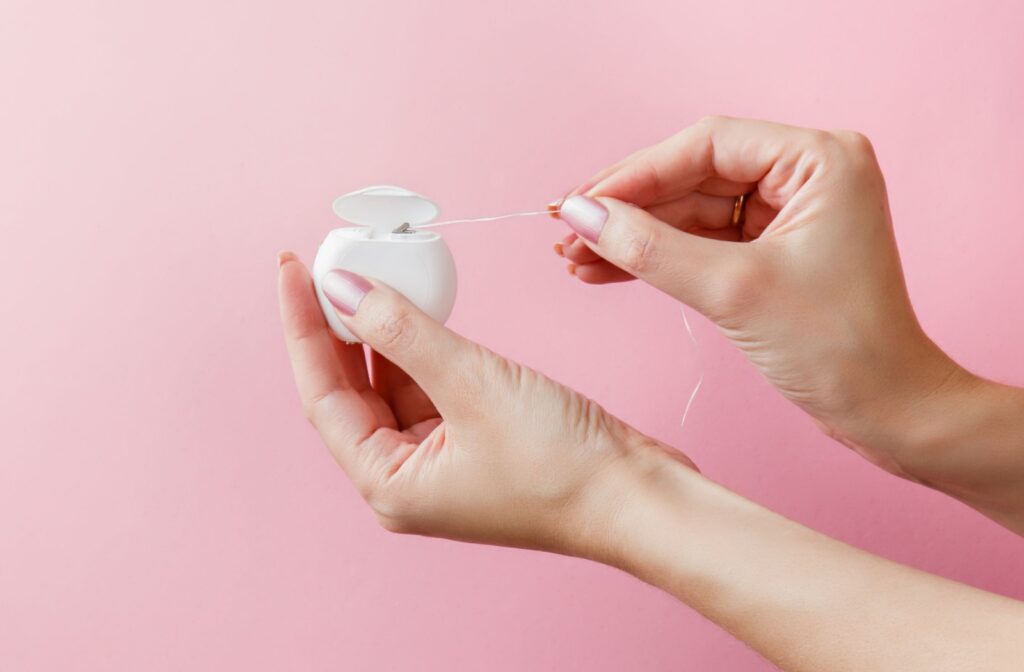Why Do My Teeth Hurt After Flossing?

You know that flossing is a key part of any oral health routine. But what happens when you finish flossing and your teeth or gums feel sore? Discomfort can be discouraging when you’re trying to build healthy habits, but it doesn’t always mean you should stop.
In most cases, discomfort after flossing is temporary and signals that your gums are adjusting or that your technique needs a gentler touch. Understanding the cause can help you move past the soreness and toward a healthier smile with improved gum health.
Common Reasons for Tooth Pain After You Floss
If you feel soreness after cleaning between your teeth, your gums are usually the source of the discomfort, not your teeth. This reaction is quite common and can be caused by a few different factors. Let’s look at what might be happening in your mouth.
You’re New to Flossing or Floss Infrequently
When you first start to floss or if it’s been a while, your gums are most likely inflamed. They may feel sensitive, tender, or even bleed a little bit at first. This is often temporary and can improve within a week or so as your gums get cleaner and healthier.
Your Technique Needs a Little Polish
How you floss is just as important as the fact that you’re doing it. Using too much force can irritate your gums and cause them to feel sore.
A few common mistakes include:
- Snapping the floss down hard between your teeth
- Pressing too firmly against your gum line
- Using a rough sawing motion instead of a gentle glide
Underlying Gum Sensitivity or Inflammation
Sometimes, sore gums can be a sign of gingivitis, which is the earliest stage of gum disease. When dental plaque builds up along the gum line, this causes inflammation, making the area sensitive. When you floss, you disturb this buildup, which can cause some temporary pain or bleeding.
Should You Floss Even if It Hurts?
The answer depends on what kind of discomfort you’re feeling. A little temporary soreness is very different from a sharp or lasting pain. It’s helpful to know how to tell the difference, so you can take the right steps.
When to Continue with Care
If the soreness is minor and goes away shortly after you finish, it’s generally encouraged to keep flossing. Your gums are most likely just adjusting to the new routine. Imagine a wound needing cleaning, it will hurt at first but is necessary to allow proper healing to begin. Be extra gentle for a few days, and you’ll probably notice the soreness fades as your gums become healthier.
When to Pause & Seek Advice
You should stop flossing and talk with our dental team if you experience sharp pain. This is also true if you have heavy bleeding that doesn’t stop quickly or discomfort that lasts for hours.

A Simple Guide for Proper & Pain-Free Floss Habits
With the right approach, you can clean between your teeth effectively without causing pain. Here’s to do it.
Choose the Right Tools
The type of floss you use can affect your comfort level. Waxed floss or a wider dental tape often glides more easily between tight teeth, causing less friction. You could also explore alternatives like water flossers or interdental brushes, which are great options for sensitive gums or around dental work.
Follow the Correct Steps
A gentle flossing technique is the key to protecting your gums from irritation. Try these steps to make your flossing experience better for you and your kids. It’s all about being slow and steady.
- Use about 45 cm of floss, wrapping most of it around one middle finger and a small amount around the other.
- Hold the floss tightly between your thumbs and index fingers.
- Gently guide the floss between your teeth with a gentle back-and-forth motion—never snap it into place.
- Curve the floss into a C-shape against one tooth. Slide it gently up and down, going slightly below the gum line.
- Repeat on the adjacent tooth, and use a clean section of floss for each space.
What a Throbbing Sensation After Flossing Means
A throbbing feeling is different from the general soreness we’ve discussed. This sensation can happen when flossing removes a piece of food or plaque from an especially inflamed area. It can feel like a rush of blood or a pulsing in your gum.
This feeling might also signal a deeper issue, like a cavity forming between your teeth that may require a dental filling. If you consistently feel a throbbing pain after you floss a certain spot, it’s a good idea to schedule a check-up. We can help you find the cause and address it.
How Your Family Dentist Can Help
Your oral hygiene routine at home is your first line of defence, but professional support is a great partner in keeping your family’s smiles healthy. Regular visits provide an opportunity to catch small issues before they become bigger problems. This teamwork between home care and professional care helps everyone maintain good oral health.
Professional Cleanings & Check-ups
During a professional dental cleaning, your dental hygienist removes hardened plaque, also known as tartar. This is something you can’t get rid of with a toothbrush or floss alone. Removing tartar gives your gums a chance to heal and can reduce sensitivity over time.
Personalized Advice for Your Family’s Oral Health
Every mouth is different, and what works for one person might not be the best for another. If you’re struggling with flossing, our team can show you and your children techniques that fit your needs. We can also recommend the right tools to make your home care routine easier and more effective.
Pain after flossing can be concerning, but it’s often a sign that your gums are on their way to becoming healthier. By using a gentle technique and the right tools, you can make it a comfortable part of your daily routine. Remember that consistency is key to overcoming initial sensitivity.
Come visit us at Dow’s Lake Dental and learn more about how to keep your smile healthy.


